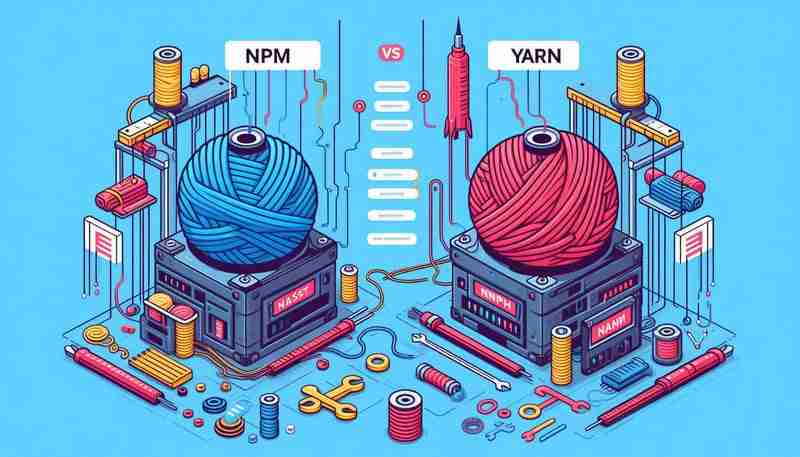npm 與yarn:主要差異與深入比較
在 JavaScript 生態系統中,選擇 npm 與 YARN 作為套件管理器可以顯著影響您的開發工作流程。 npm 和yarn 都是廣泛使用的工具,可協助開發人員管理專案中的依賴項,但每種工具都提供獨特的功能來滿足不同的專案需求。 npm 與yarn 的深入比較涵蓋了它們的主要差異、優勢和用例,可協助您為專案做出明智的決策。

1. 安裝及依賴解析
新專案管理
npm 按順序安裝依賴項並在 node_modules 資料夾中建立巢狀結構,這可能會導致安裝時間更長並可能導致依賴項重複。看起來像這樣:
project/ ├── node_modules/ │ ├── package-a/ │ │ └── node_modules/ │ │ └── package-b/ │ └── package-c/
優點:
- 熟悉程度: npm 預先安裝了 Node.js,使其成為許多開發人員的預設套件管理器。
- 廣泛的兼容性: 透過 npm 龐大的生態系統,大多數 JavaScript 專案無需額外設定即可無縫運作。
缺點:
- 效能:順序安裝可能會導致安裝速度變慢,尤其是對於大型專案。
- 巢狀依賴項:依賴項的深度巢狀可能會導致 node_modules 資料夾臃腫,有時會導致限制目錄深度的檔案系統問題。
紗
Yarn 透過使用並行安裝改進了 npm 的安裝過程,從而創建了扁平結構:
project/ ├── node_modules/ │ ├── package-a/ │ ├── package-b/ │ └── package-c/
優點:
- 速度: Yarn 的平行安裝通常比 npm 快 2-3 倍,這對於具有許多依賴項的專案來說非常有效率。
- 扁平結構:扁平資料夾結構可防止深層巢狀問題,並最大限度地降低依賴衝突的風險。
缺點:
- 額外設定: Yarn 需要與 Node.js 分開安裝,這為新使用者增加了額外的步驟。
- 小型項目的開銷:對於小型項目,yarn 的效能提升可能不那麼明顯,這使得 npm 成為更簡單的選擇。
2. 鎖定檔案和確定性構建
npm:package-lock.json
npm 使用 package-lock.json 檔案來鎖定依賴版本,確保跨環境安裝一致:
{
"name": "project",
"version": "1.0.0",
"dependencies": {
"lodash": "^4.17.21"
}
}
優點:
- 自動生成: package-lock.json 檔案自動生成,有助於確保在所有環境中安裝相同版本的依賴項。
- 向後相容性: 確保較舊的 npm 版本仍然可以正常運行,保持相容性。
缺點:
- 使用不一致(舊版):在舊版的 npm 中,預設並非總是使用 package-lock.json 文件,這可能會導致安裝不一致。
紗線:紗線.lock
Yarn 的yarn.lock 具有相同的用途,但始終預設產生並使用,以確保更具確定性的建置:
# yarn lockfile v1 lodash@^4.17.21: version "4.17.21" resolved "https://registry.yarnpkg.com/lodash/-/lodash-4.17.21.tgz" integrity sha512-v2kDEe57lec...
優點:
- 預設確定性: Yarn 的yarn.lock 檔案保證在所有環境中安裝一致。
- 總是使用: 與 npm 不同,yarn.lock 檔案始終被使用,確保每次安裝都是相同的。
缺點:
- 簡單專案的開銷: 鎖定檔案的嚴格性可能感覺像是較小或不太複雜的專案的開銷。
3. 安全特性
新專案管理
npm 提供了一個內建的 npm 審計命令,透過掃描 npm 安全諮詢資料庫來檢查專案依賴項中的漏洞:
npm audit
Pros:
- Easily Accessible: The audit feature is integrated into npm, offering developers a quick way to check for security issues.
- Large Database: npm has a vast security advisory database due to its large user base, covering many known vulnerabilities.
Cons:
- Less Detailed Reports: The npm audit command may not provide as detailed or actionable feedback as developers expect.
yarn
Yarn also has an audit command but goes further by verifying package integrity during installation. Yarn 2+ introduced "Zero-Installs," allowing projects to skip installs entirely, reducing the risk of security issues when fetching dependencies.
yarn audit
Pros:
- More Proactive: Yarn not only checks for known vulnerabilities but also validates the integrity of every package during installation.
- Zero-Installs: This feature adds another layer of security by enabling projects to be cloned and used without running yarn install, reducing potential risks.
Cons:
- Setup Complexity: For Yarn’s more advanced security features like Zero-Installs, developers need to adopt Yarn 2+, which can require additional setup and configuration.
4. Workspaces and Monorepo Support
npm Workspaces
npm introduced workspaces in version 7, allowing developers to manage multiple packages within the same project. This feature is particularly useful in monorepos, where several related packages are maintained together.
{
"name": "my-project",
"workspaces": [
"packages/*"
]
}
Pros:
- Official Support: npm’s native workspace support simplifies dependency management in monorepos.
- Familiarity: npm workspaces follow the same conventions as other npm functionality, so it’s easy to integrate into existing workflows.
Cons:
- Newer Feature: npm’s workspace implementation is relatively new and may not be as fully-featured as yarn’s.
yarn Workspaces
Yarn has supported workspaces for much longer and is generally considered more feature-rich for handling monorepos. Yarn’s workspace feature allows for more granular control over dependencies in monorepos.
{
"private": true,
"workspaces": [
"packages/*"
]
}
Pros:
- Mature Feature: Yarn’s workspaces are more robust and offer additional commands for managing multiple packages.
- Better for Large Monorepos: Yarn is generally considered the better choice for larger or more complex monorepos due to its mature implementation.
Cons:
- Learning Curve: For developers new to monorepos or Yarn’s workspace management, there may be a steeper learning curve.
5. CLI Commands and Usability
npm
npm offers a variety of commands for managing dependencies:
npm install <package> npm uninstall <package> npm update npm run <script>
Pros:
- Consistency: As the default package manager for Node.js, npm’s commands are familiar and widely used.
- Extensive Documentation: npm's extensive community and documentation make it easier for developers to find solutions to common issues.
Cons:
-
Verbosity: npm commands can be more verbose and less intuitive compared to yarn. For example, npm install
versus yarn’s simpler yarn add . - Fewer Utility Commands: While npm covers the basics, it lacks some of the utility commands yarn provides, such as yarn why for checking package dependencies.
yarn
Yarn offers similar commands but with shorter and more intuitive syntax:
yarn add <package> yarn remove <package> yarn upgrade yarn <script>
Pros:
-
Simplicity: Yarn commands are often shorter and more intuitive. For example, yarn replaces npm install, and yarn

熱AI工具

Undresser.AI Undress
人工智慧驅動的應用程序,用於創建逼真的裸體照片

AI Clothes Remover
用於從照片中去除衣服的線上人工智慧工具。

Undress AI Tool
免費脫衣圖片

Clothoff.io
AI脫衣器

Video Face Swap
使用我們完全免費的人工智慧換臉工具,輕鬆在任何影片中換臉!

熱門文章
Windows 11 KB5054979中的新功能以及如何解決更新問題4 週前 By DDD如何修復KB5055523無法在Windows 11中安裝?3 週前 By DDDInzoi:如何申請學校和大學1 個月前 By DDD如何修復KB5055518無法在Windows 10中安裝?3 週前 By DDD在哪裡可以找到Atomfall中的站點辦公室鑰匙4 週前 By DDD
熱工具

記事本++7.3.1
好用且免費的程式碼編輯器

SublimeText3漢化版
中文版,非常好用

禪工作室 13.0.1
強大的PHP整合開發環境

Dreamweaver CS6
視覺化網頁開發工具

SublimeText3 Mac版
神級程式碼編輯軟體(SublimeText3)
 神秘的JavaScript:它的作用以及為什麼重要
Apr 09, 2025 am 12:07 AM
神秘的JavaScript:它的作用以及為什麼重要
Apr 09, 2025 am 12:07 AM
JavaScript是現代Web開發的基石,它的主要功能包括事件驅動編程、動態內容生成和異步編程。 1)事件驅動編程允許網頁根據用戶操作動態變化。 2)動態內容生成使得頁面內容可以根據條件調整。 3)異步編程確保用戶界面不被阻塞。 JavaScript廣泛應用於網頁交互、單頁面應用和服務器端開發,極大地提升了用戶體驗和跨平台開發的靈活性。
 誰得到更多的Python或JavaScript?
Apr 04, 2025 am 12:09 AM
誰得到更多的Python或JavaScript?
Apr 04, 2025 am 12:09 AM
Python和JavaScript開發者的薪資沒有絕對的高低,具體取決於技能和行業需求。 1.Python在數據科學和機器學習領域可能薪資更高。 2.JavaScript在前端和全棧開發中需求大,薪資也可觀。 3.影響因素包括經驗、地理位置、公司規模和特定技能。
 如何實現視差滾動和元素動畫效果,像資生堂官網那樣?
或者:
怎樣才能像資生堂官網一樣,實現頁面滾動伴隨的動畫效果?
Apr 04, 2025 pm 05:36 PM
如何實現視差滾動和元素動畫效果,像資生堂官網那樣?
或者:
怎樣才能像資生堂官網一樣,實現頁面滾動伴隨的動畫效果?
Apr 04, 2025 pm 05:36 PM
實現視差滾動和元素動畫效果的探討本文將探討如何實現類似資生堂官網(https://www.shiseido.co.jp/sb/wonderland/)中�...
 JavaScript難以學習嗎?
Apr 03, 2025 am 12:20 AM
JavaScript難以學習嗎?
Apr 03, 2025 am 12:20 AM
學習JavaScript不難,但有挑戰。 1)理解基礎概念如變量、數據類型、函數等。 2)掌握異步編程,通過事件循環實現。 3)使用DOM操作和Promise處理異步請求。 4)避免常見錯誤,使用調試技巧。 5)優化性能,遵循最佳實踐。
 JavaScript的演變:當前的趨勢和未來前景
Apr 10, 2025 am 09:33 AM
JavaScript的演變:當前的趨勢和未來前景
Apr 10, 2025 am 09:33 AM
JavaScript的最新趨勢包括TypeScript的崛起、現代框架和庫的流行以及WebAssembly的應用。未來前景涵蓋更強大的類型系統、服務器端JavaScript的發展、人工智能和機器學習的擴展以及物聯網和邊緣計算的潛力。
 如何使用JavaScript將具有相同ID的數組元素合併到一個對像中?
Apr 04, 2025 pm 05:09 PM
如何使用JavaScript將具有相同ID的數組元素合併到一個對像中?
Apr 04, 2025 pm 05:09 PM
如何在JavaScript中將具有相同ID的數組元素合併到一個對像中?在處理數據時,我們常常會遇到需要將具有相同ID�...
 Zustand異步操作:如何確保useStore獲取的最新狀態?
Apr 04, 2025 pm 02:09 PM
Zustand異步操作:如何確保useStore獲取的最新狀態?
Apr 04, 2025 pm 02:09 PM
zustand異步操作中的數據更新問題在使用zustand狀態管理庫時,經常會遇到異步操作導致數據更新不及時的問題。 �...

















